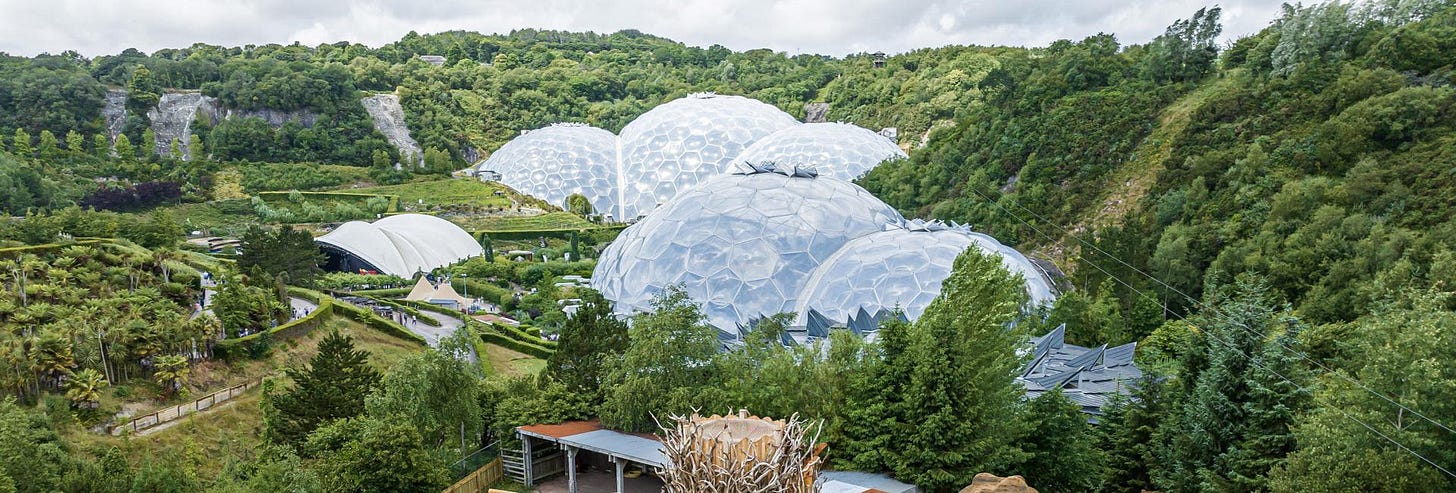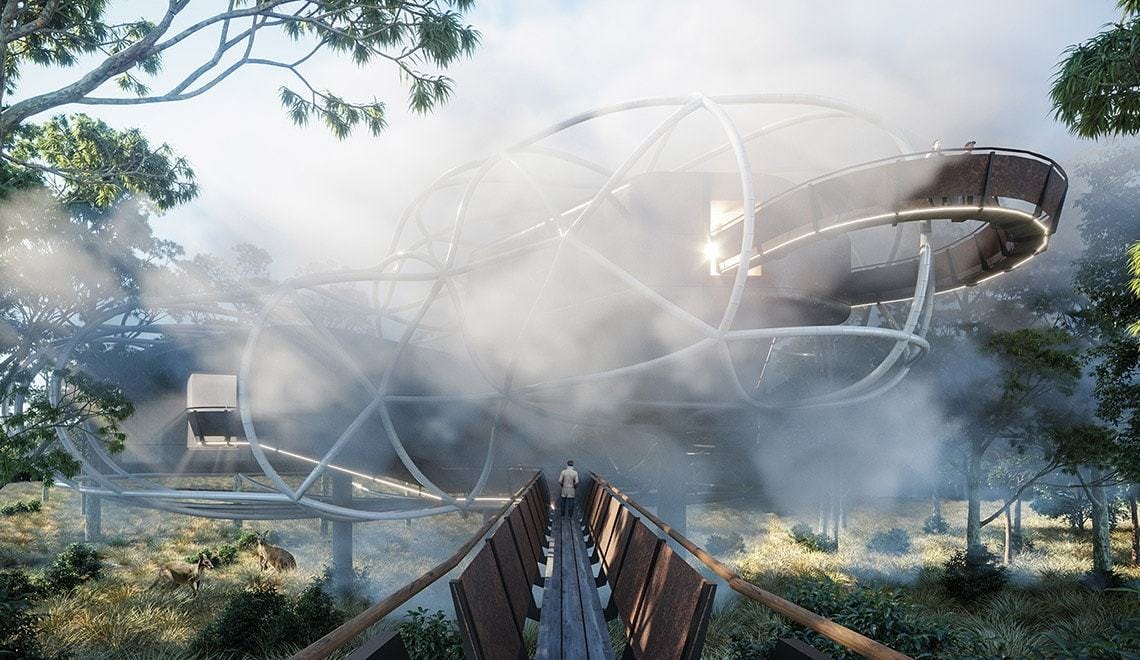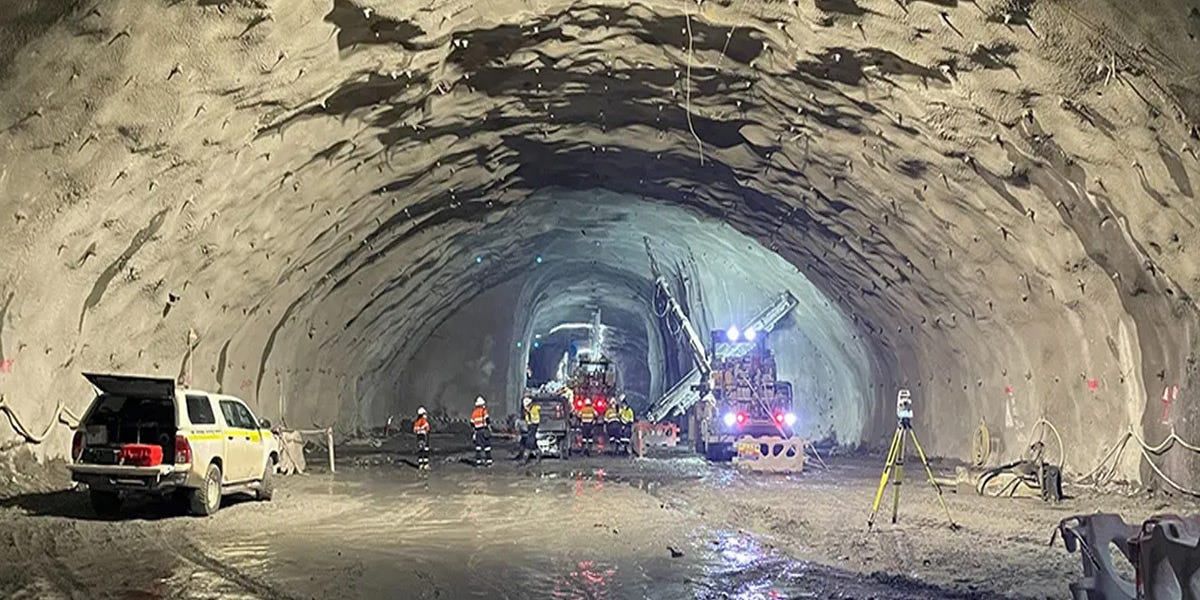The Eden Project
One of the proposed sites1 for an Australian nuclear power plant is Anglesea, a holiday town on Victoria’s Surf Coast and the start of the Great Ocean Road.
Anglesea Power Station, owned by Alcoa, was brought online in 1969 to primarily serve their Point Henry aluminium smelter (it sold excess electricity into the NEM). When the smelter shut in 2014, the future of the ageing coal station was cast in doubt, and shuttered in 2015. The site is still owned by Alcoa, who are working through the process of rehabilitating the site and have demolished everything but the chimney, which I assume is absolutely riddled with asbestos and presents something of a challenge being so close to residential homes.2
Notwithstanding the extreme and violent wave tsunami of NIMBY-ism awaiting anyone careless enough to propose building a nuclear power plant in a town whose residents are equal part surf hippies and million dollar-holiday house owners, there’s already a plan for the old site.
The Eden Project is an iconic redevelopment of a former kaolinite (china clay) mine site in Cornwall, England. Opened in 2001, it’s a futuristic visitor attraction featuring a series of geodesic biomes.3
The wild success of the Eden Project has led to it becoming something of a brand, with sister projects in other parts of the world. Even Brisbane is reportedly considering an Eden Project to rehabilitate the old Mt Cootha quarry.
Alcoa brought in the Eden Project developers to create a vision for the former power station site. The initial master plan and community consultation were completed by 2019, and since then progress on the development seems to have slowed somewhat, but is apparently still actively progressing.
Per the most recent update I could find, one of the key sticking points is the huge artificial lake constructed from the former mine. It’s considered essential to the eco-tourism site, but as of 2023 was only 17% full.
The Eden Project as a brand and concept is not only a great example of how former industrial sites could be repurposed for the benefit of the community, but also aligns with the general vibe and aspirations of the broader Surf Coast region.
The project’s completion is not guaranteed – an Eden Project in an earthquake affected section of Christchurch New Zealand was officially canned in April this year – but maybe there’s room to squeeze in just a teensy weensy little SMR beneath a biome…
Florence the Tunnel Boring Machine
Currently Speaking has long been fascinated by Florence the tunnel boring machine – she featured in our very first article.4
Named for Australia’s first female electrical engineer, Florence Violet McKenzie (née Granville), Florence the TBM was meant to be the star of the show, excavating the headrace tunnel from Tantangara Reservoir upper storage to the 2.2 GW worth of turbines in an 800m deep cavern.
Instead Florence the TBM5 made the news for all the wrong reasons – launched to great fanfare in March 2022, she got stuck in soft ground within the first 100m of her travels.
Florence (the TBM), is a 2.4 kilotonne, $150 million, 11 meter diameter behemoth. She’s a mixed-mode TBM made by Herrenknecht –able to be converted from open Single Shield mode to closed Mixshield operation depending on the rock geologies encountered.
But apparently the necessary slurry equipment wasn’t installed for the initial tunnelling section. But she slugged on, slowly, through soft ground until she became properly stuck in December 2022, causing a sinkhole above. In a bit straight out of Yes Minister, Snowy Hydro denied that there was any sinkhole until February 2023. And there Florence stayed for most of the year while the geological and environmental problems were resolved.
Earlier this year she got unstuck and back on her way and started making good progress… until yeah, stuck again. But this time in hard rock!
Florence’s woes have become emblematic of the entire Snowy 2.0 project – massively (maaaaaaaassively) over budget and behind schedule, I genuinely feel sorry for the media relations team at Snowy Hydro.
There’s a certain cruel irony watching a particularly odious type of nuclear fanboy leer at the ‘green folly’ of the current energy minister Chris Bowen, despite Snowy 2.0 being the vanity project of Turnbull and having broad bipartisan support right up until Florence got bogged, Labor was elected and Dutton decided that dog whistling was his pathway to power.
Maybe they could build an SMR in that cavern.
Gatta-car
The genre of science fiction has predicted a range of technological developments. In Fahrentheit 451, Ray Bradbury described earbuds, flatscreen TVs and ATMs long before they actually existed. Asimov’s The Minority Report included facial recognition systems and personalised advertising.
Why do they get some many predictions right? Could just be that a broken clock is right twice a day. There are some examples like Back to the Future, which predicted hoverboards being widespread in 2015. Some science fiction authors explicitly thought the role of sci-fi was to predict the future. Some technological inventions came about partially because of sci-fi.6
I watched Gattaca (1997) recently. It’s a great sci-fi film with a killer cast including Ethan Hawke, Uma Thurman and Jude Law. It focuses on a futuristic society that is centered around genetic manipulation which in turns sets up a class divide – ‘valids’ are genetically superior and get the best opportunities, including travelling to space. ‘In-valids’ are genetically unmodified and represent the lower castes.
I won’t spoil the movie – if you haven’t seen it you should definitely watch it. But watching it, something caught my eye. They’re driving EVs. The sound effects when they drive these cars around are definitely electric. They don’t really look like EVs - most cars in the movie are retro looking sedans (I’m not a car person if it’s not obvious…)

They also plug their cars in to recharge them when they get some.
The charger seems very similar the charger that was used for General Motors EV1, an EV released in 2003. The charger used an inductive charging system called Magne Charge and typically charged at 6.6kW.
Gattaca isn’t old by sci-fi standards, but it’s cool to see that the writers felt that EVs were the futuristic technology to complement the movie’s aesthetic. It’s also cool that the movie likely took some heavy inspiration from the early days of the modern EV industry, which has come incredibly far since the early 2000s.
Too bad they didn’t predict SMRs.
The federal opposition’s plan for a fleet of nuclear units and their possible sites (and some kind of modelling?) was originally due prior to the May budget, but has since been pushed back indefinitely. We wait with baited breath.
I worked at Anglesea in 2013, and I remember at least one ‘asbestos scare’ when contractors pulled the insulation lagging off a steam pipe and didn’t like the look of the powdery white substance beneath. It turned out not to be, but those are the kinds of fun things you might find in old power stations… and probably also beach shacks tbh.
If you have an eye for geodesic domes, these might look familiar – they were used as a set piece in the 2002 Bond film Die Another Day.
We reached out to the Snowy media team for an exclusive awhile back and unsurprisingly got ghosted. If anyone from Snowy is reading this, we will drive to Cooma can and provide nothing but fawning coverage if you can get us underground.
Not to be confused with TBM2 Florence, used to tunnel Sydney Metro’s North West Rail Link and named for Florence Taylor, Australia’s first female engineer and architect.
https://bigthink.com/the-present/sci-fi-predict-inspire-future/







Love to read whatever length you write but love the mix between this one (three short stories) and long.
Love the short circuits, and the fact that no Boomers were insulted this week!! 😂